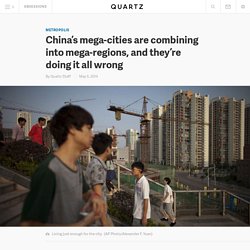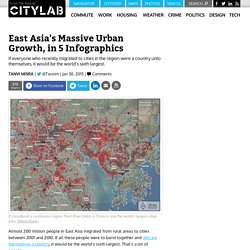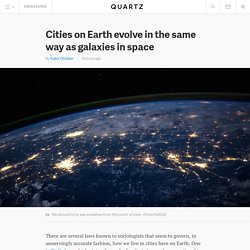

Tumblr_n6qnziKftl1qf3oz3o4_1280.jpg (JPEG Image, 1280 × 855 pixels) - Scaled (80%) Can a city become too big? There are now some three dozen megacities in the world, each sprawling areas home to more than 10 million people.

Bigger cities come with obvious advantages, the increase in people, interactions and infrastructures create more opportunities and efficiencies. But massive population growth has also led to more pollution, spiralling rent, and crumbling infrastructure. These problems, according to theoretical physicist Geoffrey West, increase alongside population growth. "The bigger you are the more you get per capita. So the bigger you are, the more Aids cases there are, the more higher wages, the more crime there is, the more patents are produced and so forth. West says all the super-sized cities around the world seem to share this concept of super-linear scaling.
While they may share the same principles, the reasons driving them are very different. The problem is this type of planning often doesn’t pay any attention to human nature, says urban planner Wendell Cox. Neither was a success.
Chongqing. Big Cities Head for Water Crisis as Populations Explode. Water pots waiting to be filled from a street tap in Chennai, India.

(McKay Savage via Wikimedia Commons) This Creative Commons-licensed piece first appeared at Climate News Network. LONDON—More than 40% of the world’s great cities supplied by surface water could become vulnerable to shortages and drought by 2040, according to new research. And more than three out of 10 were already vulnerable in 2010. Meanwhile, the vital array of satellites designed to monitor rainfall and to warn of potential flooding is reported to be coming to the end of its shelf life. Urban Planning Ideas for 2030, When Billions Will Live in Megacities. The statistics are staggering: Researchers predict that by 2025, the world will have 37 megacities, defined as urban areas with more than 10 million people.

New York City and Newark are expected to have more than 23 million inhabitants; Tokyo, more than 38 million people. All told, well over half of the world’s population will be living in these super settlements. “One number that isn’t referenced often is that two-thirds of that population will be poor,” says Pedro Gadanho, who curated Uneven Growth: Tactical Urbanisms for Growing Megacities at MoMA. That poverty translates into informal cities, like the favelas of Rio de Janeiro or illegally subdivided high-rises of Hong Kong. Megacities Are Growing So Fast We Need Satellites To Study Them. China’s mega-cities are combining into mega-regions, and they’re doing it all wrong. This item has been corrected.

URBAN GEOGRAPHIES: Cities / Places / Regions. East Asia's Massive Urban Growth, in 5 Infographics. Almost 200 million people in East Asia migrated from rural areas to cities between 2001 and 2010.

If all these people were to band together and declare themselves a country, it would be the world's sixth largest. That's a lot of people. A new World Bank report uses satellite imagery and geospatial mapping to compare this influx of people with the expansion of urban areas from Mongolia and Myanmar on up to Japan. It finds that although cities in the region expanded at breakneck speeds during this period, they couldn't keep up with ballooning urban populations.
New residents poured into cities at an average of 3 percent per year, while land expansion happened at a 2.4 percent annual rate, according to the report. China rules the roost, accounting for 80 percent of the region's urban land growth. In terms of population growth, as well, China is formidable. The report also examines the link between urbanization and a country's GDP. China Plans to Move 250 Million into Cities by 2025. The Chinese government is pushing forward with a plan that will move 250 million Chinese people from rural communities into newly constructed towns and cities over the next 12 years.

The government has been bulldozing ancient villages, temples and open-air theaters as well as paving over farmland to make way for mega-cities that will raise the number of city-dwellers in China to nearly the total urban population of the US. To find out how and why this is happening, keep reading. Cities - The Real Shanghai 1 of 2 - BBC Travel Documentary. Megacities Reflect Growing Urbanization Trend. National Geographic Documentary - Mega Cities - Hong Kong. Bright lights, big cities. Cities on Earth evolve in the same way as galaxies in space. There are several laws known to sociologists that seem to govern, in unnervingly accurate fashion, how we live in cities here on Earth.

One is Zipf’s law, which states the rank of a city is inversely proportional to the number of people who live in the city. So the biggest city in a country has 10 million people, then the second-biggest city is 10 million divided by two, the next by three, and so on. While most of these scaling laws, such as Zipf’s law or ones that determine the spread of sexually-transmitted diseases, have been observed to be true in the wild, we don’t have any real sense of where they come from or why they work.
Scientists now think they have found the source for these scaling laws out in space. Henry Lin and Abraham Loeb at the Harvard-Smithsonian Centre for Astrophysics have used models for showing how galaxies evolve based on matter density to propose a unifying theory for scaling laws of human populations. Strange Visions of the Hyper-Congested Megacities of the Future. Timeout IV—Hardy Road, Spring, Texas, USA Marcus Lyon.

Mekong Delta & HCMC. Megacities, Mega regions. Future of cities.